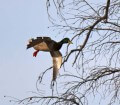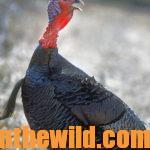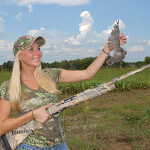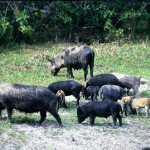John’s Note: Early Americans saw the sport of duck hunting quite differently from how we view it today. In the days of the Pilgrims, an estimated 1/2-billion ducks inhabited America. Duck hunting involved no sport. The meat provided vittles, and you bagged them any way you could. Many of the early outdoorsmen stalk-hunted ducks.
The first settlers observed the way Indians hunted ducks. Realizing the bow and arrow couldn’t accurately shoot at great distances or consistently down ducks on the wing, the Indians knew they had to lure waterfowl in close if they wanted to take them. The native red man practiced the tactics of the fox. Since a fox couldn’t out-fly or out-swim a duck, he had to lure the duck in close enough to ambush it. For this reason, foxes hunted in pairs when trying to take a duck dinner. One wily fox moved silently and quietly to an ambush point close to shore. The other fox would race up and down the shoreline.
The ducks rafting out in the water would become interested in the fox and swim toward it, squawking and quacking angrily. Some of the rafting ducks even would fly toward the fox and squawk and fuss at it. The ducks, continuing to squawk, would move closer and closer to the frantic fox running up and down the shoreline. Soon the birds would walk within striking distance of the second fox hidden in the grass on the bank. When the attack came, the fox lying in wait might kill one to three ducks before they flew off.
 When the Indians observed this natural phenomenon, they modified the game of the fox and the duck by using a fox skin and a rope. Two braves would get on either side of an inlet and hide in the brush. Using the rope and the fox skin, they would drag the fox skin back and forth across the shoreline, much like the antics of the decoy fox. The ducks would see the fox skin going back and forth on the bank and move in to squawk at the fox. Then the waiting Indians would arrow the ducks.
When the Indians observed this natural phenomenon, they modified the game of the fox and the duck by using a fox skin and a rope. Two braves would get on either side of an inlet and hide in the brush. Using the rope and the fox skin, they would drag the fox skin back and forth across the shoreline, much like the antics of the decoy fox. The ducks would see the fox skin going back and forth on the bank and move in to squawk at the fox. Then the waiting Indians would arrow the ducks.
The French and Spanish explorers observed the fox game of the Indians for taking waterfowl. Back in their countries, they trained and bred red, shaggy dogs with white blazes on their faces and paws and fluffy tails like foxes. They called these dogs, which they trained to go back and forth along the shoreline retrieving a stick, tolling dogs (Tolling is an old 13th century word meaning to seduce or entice). Frenchmen often set up in three blinds and waited for the ducks to move in to the tolling dog. When the ducks came close to the bank, the hunters who threw the stick for the dog to retrieve would shoot the waterfowl on the water. When the second blind heard the blast from the first blind, they immediately would fire a foot to a foot and a half above the water, catching the ducks that jumped in the air. Then the third blind of hunters, once they heard the report of the shotguns from the second blind, would fire 3 or 4 feet above the water and take any ducks that escaped the first two volleys. The tolling dog/three blind tactic became a deadly harvesting tool for large numbers of waterfowl in one morning’s outing.
In the eastern U.S. in the late 1700s and 1800s where large rafts of ducks came through every winter, the occupation of market hunting flourished. Besides the fact that people needed ducks for food, farmers fed them to their pigs, also. This vast demand for market gunners meant a man who loved to hunt could hunt and earn a living at the same time.
The great abundance of waterfowl must have seemed non-ending as Thomas Morton wrote in the 17th century that he had had more than 1000 geese before the muzzle of his gun at one time. Another historian recorded that he had seen the harbor at Lynn, Massachusetts, frequently so covered with ducks and geese that he couldn’t see the water. The smooth-bore, black-powder fowling pieces grew bigger each year, developing at last into small swivel cannon known as punt guns mounted on boats. These black-powder guns could almost wipe out a flock of swimming ducks. For instance, many of the market gunners in later years on the Texas Gulf Coast averaged taking 200 ducks each daily. One man figured to have killed about 360,000 ducks in his 16 years of market gunning. By 1900, only 150 million ducks and geese survived in the U.S.
 Taking Early 20th Century Ducks
Taking Early 20th Century Ducks
In the 20th century, men bagged quacks with more sophisticated methods by forming clubs. Many times the clubs employed a decoy man year-round who had charge of breeding and training live decoy ducks. He would catch up a dozen ducks of each sex at a time. Over a series of months he would teach the drakes to fly in formation over the water while leaving the females tethered in the water. Eventually the trainer would hitch the females to a running line which led from the blind through a pulley to a buoy 150 yards offshore. Then the female ducks rode this line in the roughest weather without flapping or squawking when someone pulled the line to decoy in the wild ducks. Most frontiersmen didn’t employ these methods but rather used tactics still effective today for the black-powder hunter.
To learn more about John E. Phillips’ Kindle, print and Audible outdoor books, go to www.amazon.com/John-E.-Phillips/e/B001HP7K6O. Or, visit Nook Books at www.barnesandnoble.com.
You can download free books by going to https://johninthewild.com/free-books.











